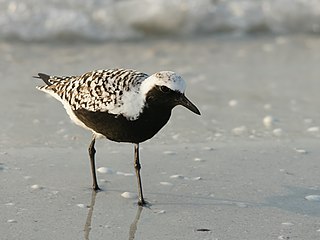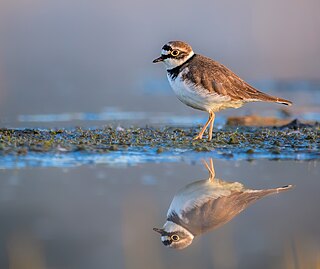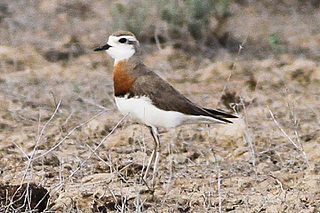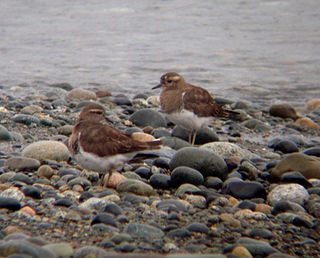
The semipalmated plover is a small plover. Charadrius is a Late Latin word for a yellowish bird mentioned in the fourth-century Vulgate. It derives from Ancient Greek kharadrios a bird found in ravines and river valleys. The specific semipalmatus is Latin and comes from semi, "half" and palma, "palm". Like the English name, this refers to its only partially webbed feet.

The common ringed plover or ringed plover is a small plover that breeds across much of northern Eurasia, as well as Greenland. The genus name Charadrius is a Late Latin word for a yellowish bird mentioned in the fourth-century Vulgate. It derives from Ancient Greek kharadrios a bird found in ravines and river valleys. The specific hiaticula is Latin and has a similar meaning to the Greek term, coming from hiatus, "cleft" and -cola, "dweller".

The grey plover or black-bellied plover is a large plover breeding in Arctic regions. It is a long-distance migrant, with a nearly worldwide coastal distribution when not breeding.

The little ringed plover is a small plover. The genus name Charadrius is a Late Latin word for a yellowish bird mentioned in the fourth-century Vulgate. It derives from Ancient Greek kharadrios a bird found in river valleys. The specific dubius is Latin for doubtful, since Sonnerat, writing in 1776, thought this bird might be just a variant of common ringed plover.

The greater sand plover is a small wader in the plover family of birds. The spelling is often given as "greater sandplover" or "greater sand-plover", but the official IOC and British Ornithologists' Union spelling is "Greater Sand Plover". The specific leschenaultii commemorates the French botanist Jean Baptiste Leschenault de la Tour. Like most other species in the genus Anarhynchus, it was until recently included in the genus Charadrius.

The Caspian plover is a wader in the plover family of birds. The specific asiaticus is Latin and means "Asian", although in binomials it usually means the type locality was India.

Wilson's plover is a small bird of the family Charadriidae.

Kittlitz's plover is a small shorebird in the family Charadriidae that breeds near coastal and inland saltmarshes, sandy or muddy riverbanks or alkaline grasslands with short vegetation. It is native to much of Sub-Saharan Africa, the Nile Delta and Madagascar. It is thought to be mainly polygamous and has monomorphic plumage.

The terrestrial fauna of the Cocos (Keeling) Islands is unsurprisingly depauperate, because of the small land area of the islands, their lack of diverse habitats, and their isolation from large land-masses. However, the fauna dependent on marine resources is much richer.

The red-capped plover, also known as the red-capped dotterel, is a small species of plover.

The inland dotterel is an endemic bird of the arid Australian interior. It forms loose flocks in sparsely vegetated gibber plain and claypans in the day where it loafs in the shade and eats shoots of shrubs. It is most often encountered at night when it forages on roads for insects. The relative remoteness of its habitat means that it is not well studied. The most detailed observations of the species were made by the South African arid-zone ornithology specialist Gordon Maclean in the 1970s. Alternate English names include Australian plover, inland plover, desert plover and prairie plover.

The wrybill or ngutuparore is a species of plover endemic to New Zealand. It is the only species of bird in the world with a beak that is bent sideways in one direction, always to the right. A 2015 study found it to be within the Charadrius clade, with other New Zealand plovers its closest relatives; the nearest being the New Zealand dotterel or New Zealand plover, and then the double-banded plover or banded dotterel.

Forbes's plover or Forbes's banded plover is a small wader. This plover is resident in much of west Africa, mainly on inland rivers, pools and lakes. Its nest is a scrape lined with small pebbles in rocky uplands. After breeding in the wet season, this bird moves to open grasslands, including airfields and golf courses, in the dry season. It is sometimes seen at pools or reservoirs.

The river lapwing is a lapwing species which breeds from the Indian Subcontinent eastwards to Southeast Asia. It range includes much of northern and northeastern India, and extends through Southeast Asia to Vietnam. It appears to be entirely sedentary. Formerly also called spur-winged lapwing, this name is better reserved for one of the "spur-winged plovers" of old, Vanellus spinosus of Africa, whose scientific name it literally translates. The masked lapwing of Australasia was at one time also called "spur-winged plover", completing the name confusion.

The two-banded plover is a species of bird in subfamily Charadriinae of family Charadriidae. It is found in Argentina, Brazil, Chile, the Falkland Islands, and Uruguay.

The rufous-chested dotterel or rufous-chested plover, is a species of bird in subfamily Charadriinae of family Charadriidae. It is found in Argentina, Brazil, Chile, Uruguay, and the Falkland Islands.

The chestnut-banded plover is a species of bird in the family Charadriidae. This species has a large range, being distributed across Southern Africa. However, it occupies a rather small area.

The long-billed plover is a species of wading bird in the family Charadriidae. It can be found in Bangladesh, Bhutan, Brunei, Cambodia, China, Hong Kong, India, Indonesia, Japan, Laos, Malaysia, Mongolia, Myanmar, Nepal, North Korea, Russia, South Korea, Sri Lanka, Taiwan, Thailand, and Vietnam. The long-billed plover is a migratory bird, so it breeds and spends the winter in different parts of its range. This bird can often be spotted along the shores of rivers, streams, in wetlands, and rice fields. It forages on the shoreline primarily for aquatic insects, insect larvae, and other invertebrates. It is difficult to distinguish between male and female individuals because of their similar plumage. The breeding season starts at the end of February or early March and ends in July. A male and a female forms a monogamous pair and maintains their territory throughout the breeding season. A global population survey in 2016 assessed the long-billed plover as a species of least concern on the International Union for Conservation of Nature (IUCN) Red List.

The Australian pratincole is a species of bird in the family Glareolidae. It breeds in Australia's interior and winters in northern and eastern parts of the continent, Indonesia and New Guinea. It is a medium-sized nomadic shorebird but is commonly found in arid inland Australia. It breeds predominantly from south-western Queensland to northern Victoria, and through central Australia to the Kimberley region in Western Australia. The Australian population is estimated at 60,000 individuals.

The Oriental reed warbler is a passerine bird of eastern Asia belonging to the reed warbler genus Acrocephalus. It was formerly classified as a subspecies of the great reed warbler of the western Palearctic.





















